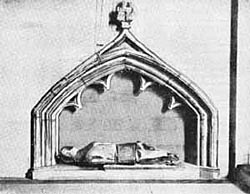< Previous | Contents | Next >
The Stone Man, West Bridgford church
 |
THE "Stone Man" of West Bridgford is a timely reminder of the antiquity of West Bridgford, a fact which the manifold modern amenities of that pleasant suburb tend to make us forget. The very dedication of the church to St. Giles, the patron of beggars and outcasts, helps us to realise that West Bridgford is, in spite of all, by no means entirely modern.
The earliest knowledge that we have of this monument is that about the time of the battle of Waterloo it was standing upright near the junction of the Melton and Loughborough roads and was used as a manorial boundary.
Its armour and other indications, however, show it to be far older than that, and it dates, in fact, from the reign of Edward I., so that this battered effigy gives to these who have eyes to see a true indication of the panoply of the soldiers who fought against William Wallace, and who helped The Hammer of the Scots to subdue that high spirited nation.
Once, glowing with colour, it no doubt occupied an honoured place in the village church of West Bridgford, and it is impossible to say how and when it was debased to the utilitarian purposes of a manorial boundary.
Mercifully, it has been restored to its consecrated home, and lies serenely under a carefully restored and preserved Fourteenth Century arch—dating from the time of the Battle of Crecy—in the morning chapel of the modernised church of West Bridgford.
The late Mr. Harry Gill was at great pains to discover who the Stone Man represented, and concluded that it is a portrait of Sir Robert Luteril, who in 1315 or thereabouts was lord of the manor.
